Last year's predictions weren't that great (the predictions for 2010 were better), but predicting the future is an addictive game, so I'll try again. Here are my predictions for 2012:
1. Oflline Google stores that will sell Chromebooks, Android phones, Google TV boxes, Google-branded shirts and more.
[ update: not true yet ]
2. Google Music will become a subscription service.
[ update: Google Play Music All Access, launched in May 2013 ]
3. Google will focus on improving the quality of Android apps. It will offer better tools for creating consistent user interfaces, it will review some of the new apps and applications will be able to request additional permissions after they've been installed.
[ update: Android Studio, automated malware scanning, 60000 low-quality apps removed ]
4. Google Games - a new service for multiplayer games that will combine the best games for Chrome, Android and Google+, while syncing your data, ranking users and allowing you to challenge your friends.
[ update: Google Play Games (May 2013) ]
5. A new music editing online service that will only work in Chrome (and probably other Chrome-only services).
[ update: not true ]
6. ARM Chromebooks (notebooks and tablets) and ARM Google TV boxes will be cheaper and more successful.
[ update: true for the Chromebooks (best selling laptop on Amazon); ARM Google TV boxes are cheaper, but not that successful ]
7. Google+ will have at least 300 million users at the end of 2012 and will incorporate many existing Google apps. Google will aggressively promote the service and will even integrate it with Chrome.
[ update: 500 million users in December 2012 ]
8. Google Instant Answers - an improved OneBox that will offer some of the detailed answers that are available in Wolfram Alpha.
[ update: Google Knowledge Graph (May 2012) ]
9. A virtual assistant for Android that will be more powerful than Siri and it will also be available in the desktop Google interface as an upgrade for voice search. Google will get better at supporting natural language queries.
[ update: launched in June 2012 ]
10. Google's navigation menu will be customizable and the notification box will support new services.
[ update: not true ]
11. The first Google-branded Motorola phones and tablets.
[ update: not true ]
12. Google search results personalized based on information from your calendar, Google+ posts, the apps you install etc.
[ update: search plus your world (January 2012), Gmail Field Trial (August 2012) ]
13. Google Doodle Creator - a service that lets you create a doodle and share it with your friends.
[ update: not true ]
14. Image Search will be able to analyze images and recognize multiple objects and people.
[ update: not true ]
15. Chrome Web Store apps and extensions for Android.
[ update: not true ]
16. YouTube's HTML5 player will become the default player.
[ update: not true ]
17. YouTube's new TV-like channels will combine some of the best videos that are available.
[ update: paid YouTube channels (May 2013) ]
18. The largest fine in Google's history.
[ update: $22.5 million in August 2012 for Safari tracking ]
19. Blog commenting service powered by Google+.
[ update: launched in April 2013 ]
20. Google+ Answers service replaces Aardvark.
[ update: not true ]
21. An online Chrome dashboard will let you access your data (bookmarks, passwords, apps) even when you don't use Chrome.
[ update: not true ]
22. Better Google Docs for tablets, Google Drive - a new name for the Google Docs list, apps for syncing files and more free storage.
[ update: Google Drive launched in April 2012 ]
December 31, 2011
December 22, 2011
YouTube's Snow Effects
If you liked Google's "let it snow" Easter egg, YouTube has some special effects for you. YouTube's player has a new button for snow, the progress bar includes a snowflake, while the search results page for queries like [snow] or [Christmas] use a simplified snow animation.

{ Thanks, Sterling, Venkat and Cookie Lee. }

{ Thanks, Sterling, Venkat and Cookie Lee. }
December 21, 2011
The Google News Search Box
The Google News homepage uses a special search box with a few interesting features. Google only shows a list of suggestions and doesn't use Google Instant, even if this feature is available for the Google News results pages. The last suggestion lets you search the web and you can use the up arrow key to select it or just press Shift+Enter. A similar feature is available in Gmail, but you can't use the Shift+Enter shortcut.
When Google redesigned Google News and other services, the "Web Search" button seemed extraneous and it was removed.
Offline Google eBooks
"I find it amusing that reading books offline is a new feature." (Krewe Maynard)
If you've used Google eBooks for Android or iPhone, you probably noticed that the mobile apps had a clear advantage over the desktop app: you could download books to your device and read them offline. The same feature is now available in the desktop app, but only if you use Chrome.
Just like the apps for Gmail and Google Docs, Google eBooks requires some advanced features that can only be enabled by installing a Chrome Web Store app. Another shortcoming is that the offline version of Google eBooks can only be accessed by clicking the app icon or by bookmarking its special URL and not by visiting books.google.com.
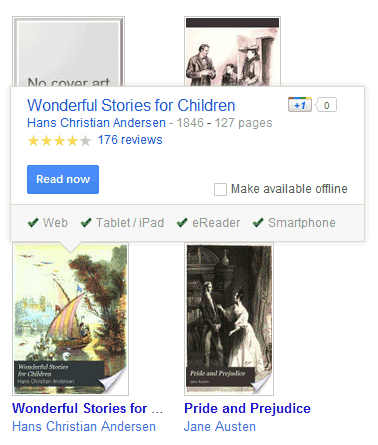
To be able to read a book offline, you need to mouse over the book and click "Make available offline". Advanced features don't work offline, even if not all of them are disabled. You can't search inside a book, take notes or highlight some text.
Right now, the offline app is pretty flaky and buggy. Sometimes you need to wait a few seconds to load the list of books because the app tries to connect to the server. Some of the time, the books didn't even load. Offline Google eBooks looks like an experimental app, but it's nice that you can still try it and help Google improve it. Hopefully, the app will work in other browsers.
{ Thanks, Venkat. }
Google's Christmas Decorations
It's no longer a surprise, since it happens every year. Google shows a colorful bar above the search results when you search for [Christmas], [Xmas] and other Christmas-related queries. There's also a special bar for Hanukkah.
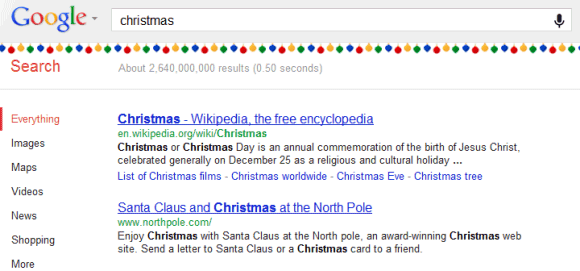
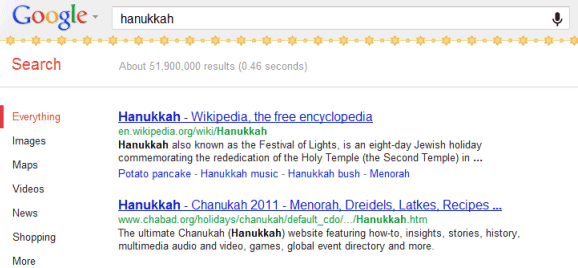
You can also check the decorations from 2006, 2007, 2008, 2010, when Google also celebrated Kwanzaa and Festivus, the famous Seinfeld holiday.
{ Thanks, Venkat. }


You can also check the decorations from 2006, 2007, 2008, 2010, when Google also celebrated Kwanzaa and Festivus, the famous Seinfeld holiday.
{ Thanks, Venkat. }
December 20, 2011
Updated Interface for Google Bookmarks
After removing the lists feature, Google Bookmarks updated the interface to match all the other Google services. It's nice to see that Google Bookmarks still exists, but the service only integrates with Google Web History and Google Toolbar for Internet Explorer. The integration with Google search has been removed, now that Google focuses on Google+, and the Android ICS browser uses the bookmark sync service from Chrome.
Google will have to find a way to merge Google Bookmarks with Chrome's bookmark sync. Google Toolbar could show the bookmarks saved in Chrome, while Google Bookmarks could be a web interface for Chrome's bookmarks. Unfortunately, Chrome uses folders, while Google Bookmarks uses labels, so merging the bookmarks is not an easy task.
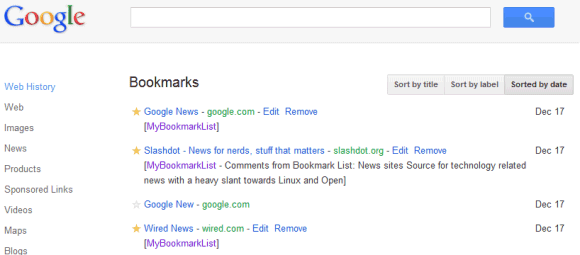
Google will have to find a way to merge Google Bookmarks with Chrome's bookmark sync. Google Toolbar could show the bookmarks saved in Chrome, while Google Bookmarks could be a web interface for Chrome's bookmarks. Unfortunately, Chrome uses folders, while Google Bookmarks uses labels, so merging the bookmarks is not an easy task.

December 17, 2011
Google's Snowy Easter Egg
If you search for [let it snow] using Google, you'll have a hard time checking the search results. Google uses a JavaScript animation that adds some snowflakes and covers the entire page with snow.
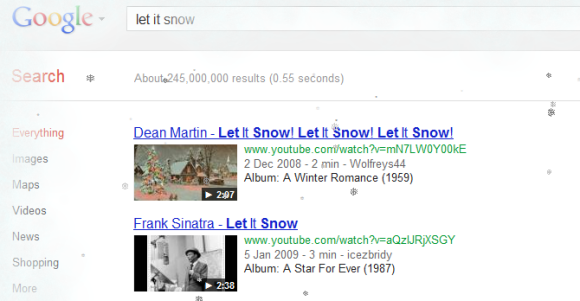
Fortunately, Google added a "defrost" button that makes the search results reappear. You can also click anywhere on the page and move your mouse to "defrost" the page or draw something. Click the "+" button and you can share the Easter egg with other Google+ users.
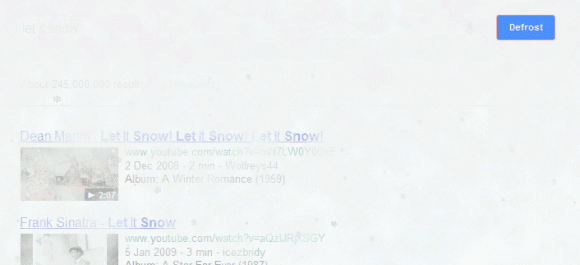
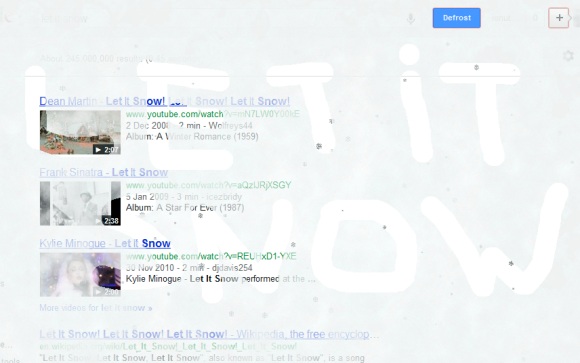
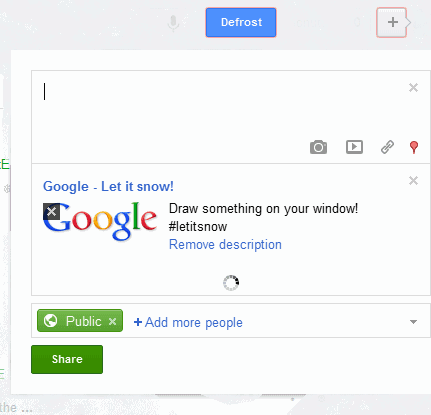
{ Thanks, Venkat. }

Fortunately, Google added a "defrost" button that makes the search results reappear. You can also click anywhere on the page and move your mouse to "defrost" the page or draw something. Click the "+" button and you can share the Easter egg with other Google+ users.



{ Thanks, Venkat. }
December 16, 2011
Google Zeitgeist 2011
Google Zeitgeist 2011, the list of the fastest rising queries in 2011, brings a great news for Google: the second most popular query this year was [Google+]. It's the first time in Google's history when a Google service makes the top 3. In 2005, [orkut] was the 5th gainer, while [youtube] was the 6th fastest rising query in 2007.
"Google+ became the fastest growing social network, acquiring more than 10 million users in three weeks. From July 3 - 17, Google+ and related keywords like Google Plus and Google + had more traffic than the keyword Sports," explains Google.
Here's the top 10:
1. Rebecca Black
2. Google+
3. Ryan Dunn
4. Casey Anthony
5. Battlefield 3
6. iPhone 5
7. Adele
8. 東京 電力 (Tokyo Electric Power Company)
9. Steve Jobs
10. iPad2
It's interesting to notice that 2011 is the first year since 2007 when Facebook is no longer included in the top 10 rising queries. Google+ is actually the only online service from the top 10, down from 6 services last year (Chatroulette, Friz, Myxer, Twitter, Gamezer, Facebook).
Here's the year in review:
"Google+ became the fastest growing social network, acquiring more than 10 million users in three weeks. From July 3 - 17, Google+ and related keywords like Google Plus and Google + had more traffic than the keyword Sports," explains Google.
Here's the top 10:
1. Rebecca Black
2. Google+
3. Ryan Dunn
4. Casey Anthony
5. Battlefield 3
6. iPhone 5
7. Adele
8. 東京 電力 (Tokyo Electric Power Company)
9. Steve Jobs
10. iPad2
It's interesting to notice that 2011 is the first year since 2007 when Facebook is no longer included in the top 10 rising queries. Google+ is actually the only online service from the top 10, down from 6 services last year (Chatroulette, Friz, Myxer, Twitter, Gamezer, Facebook).
Here's the year in review:
Calling All the Crazy Ones
While watching this ad for Galaxy Nexus...
"Calling all pretty faces, all visionaries, all the pass-it-alongers, all meeters and greeters, all wandering navigators, and mad scientists. All high-defers, all late-night poets and daylight dreamers. The possibilities are calling."
... I realized that there's a famous ad which uses a similar enumeration. It's Apple's "Crazy Ones" commercial from 1997. Here's the unaired version narrated by Steve Jobs (you can also watch the version that aired on TV):
"Here's to the crazy ones. The misfits. The rebels. The troublemakers. The round pegs in the square holes. The ones who see things differently. They're not fond of rules. And they have no respect for the status quo. You can quote them, disagree with them, glorify or vilify them. About the only thing you can't do is ignore them. Because they change things. They push the human race forward. While some may see them as the crazy ones, we see genius. Because the people who are crazy enough to think they can change the world, are the ones who do."
"Calling all pretty faces, all visionaries, all the pass-it-alongers, all meeters and greeters, all wandering navigators, and mad scientists. All high-defers, all late-night poets and daylight dreamers. The possibilities are calling."
... I realized that there's a famous ad which uses a similar enumeration. It's Apple's "Crazy Ones" commercial from 1997. Here's the unaired version narrated by Steve Jobs (you can also watch the version that aired on TV):
"Here's to the crazy ones. The misfits. The rebels. The troublemakers. The round pegs in the square holes. The ones who see things differently. They're not fond of rules. And they have no respect for the status quo. You can quote them, disagree with them, glorify or vilify them. About the only thing you can't do is ignore them. Because they change things. They push the human race forward. While some may see them as the crazy ones, we see genius. Because the people who are crazy enough to think they can change the world, are the ones who do."
A Great Ad for Galaxy Nexus
Sometimes you need a great ad to show that your product stands out. Now that Galaxy Nexus is finally available in the US, Google uploaded some promotional videos. One of them is good enough to be a TV ad:
"With Hangouts, the unplanned meet-up comes to the web — and the phone. Let buddies know you're hanging out and see who drops by. Chat face to face with a group of up to ten people using your 1.3-MP front-facing camera, all on the go," explains Google.
"With Hangouts, the unplanned meet-up comes to the web — and the phone. Let buddies know you're hanging out and see who drops by. Chat face to face with a group of up to ten people using your 1.3-MP front-facing camera, all on the go," explains Google.
No More Cosmic Panda
When YouTube launched the new interface, it was obvious that Cosmic Panda was just an experiment and its purpose was to test some new features. Now Cosmic Panda is no longer available and users have been switched to the regular interface.
"Yesterday marked the last day of the channels and watch experiment, otherwise known as Cosmic Panda. Contrary to what some might have thought, Cosmic Panda was not the new version of YouTube to come, but just an experiment we used to test out some new and interesting ideas. Since launching the experiment in July, we learned a lot and incorporated many results of the experiment into our recent homepage and channels update, which you're using now. We're happy with what we found and are now bringing Cosmic Panda to a close," informed a Google employee.
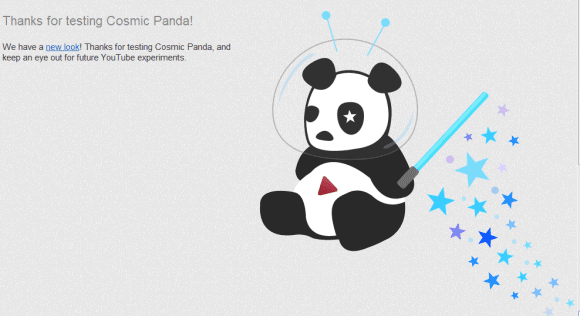
"Yesterday marked the last day of the channels and watch experiment, otherwise known as Cosmic Panda. Contrary to what some might have thought, Cosmic Panda was not the new version of YouTube to come, but just an experiment we used to test out some new and interesting ideas. Since launching the experiment in July, we learned a lot and incorporated many results of the experiment into our recent homepage and channels update, which you're using now. We're happy with what we found and are now bringing Cosmic Panda to a close," informed a Google employee.

December 14, 2011
Gmail Scribbles
Gmail's app for iOS and mobile Gmail added a cool feature that's not even available in the desktop interface: Gmail Scribbles. "You can now open up a canvas and scribble a message that will be attached to your email. It's perfect for sending a quick sketch that is hard to express in words or adding a fun graphic to make your email more personal. Scribbles support different colors, brush sizes, lines, erasers and spray paint." Maybe Scribbles is just a sneak peek at an upcoming mobile version of Google Drawings.
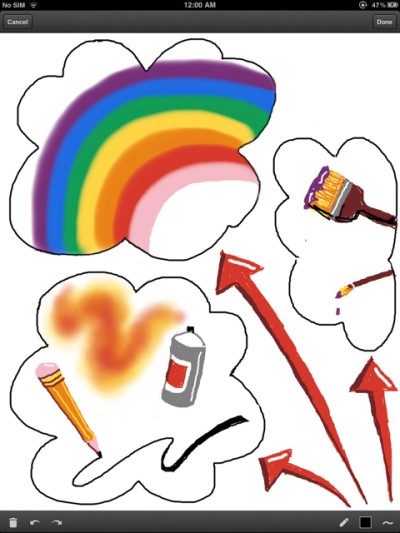
Gmail 1.1 for iOS also changed the notification sound, added better support for nested labels and Google+ Circles. The settings page that was available in the mobile web app, is now included in the iOS app, so you can add a custom signature and a vacation responder.

Gmail 1.1 for iOS also changed the notification sound, added better support for nested labels and Google+ Circles. The settings page that was available in the mobile web app, is now included in the iOS app, so you can add a custom signature and a vacation responder.
New in Chrome 16: Profiles and Cloud Print for Any Page
Chrome 16 is ready for primetime and it brings some new features:
1. The print preview page now integrates with Cloud Print. That means you can now print any webpage or PDF file using Cloud Print.
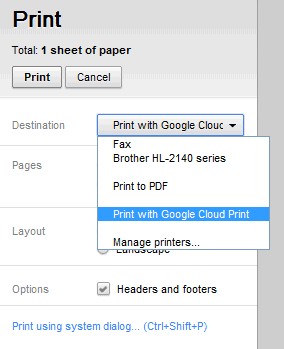
While Cloud Print makes more sense on a mobile phone or a tablet, you can also use it on your computer. The printer management page lets you share printers with your contacts just like you would share files in Google Docs. You're no longer limited to sharing a printer with other computers on the same network.
2. Chrome now has an interface for creating profiles. Go to Options > Personal Stuff and click "Add new user". After creating a new profile, Google asks you to log in using a Google Account and sync your settings and data, but this is optional. You can change the profile name and the icon that's always displayed in the top-left corner of the window. Profiles work just like the incognito mode, except that the data is saved and you can use multiple profiles at the same time. Just click the profile icon and you can open a new window in a different profile.
It's important to keep in mind that profiles can't be password-protected and they aren't intended to replace the user accounts from your operating system. Profiles are useful if you need different settings, bookmarks, apps at work, at school or in your past time. You can create a profile for games, install your favorite games from the Chrome Web Store, download a game-related theme and add some bookmarks.
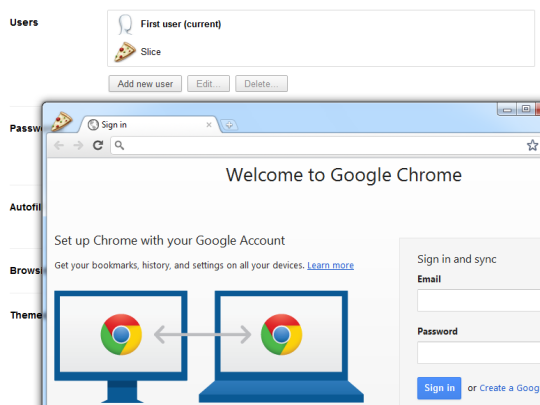
3. YouTube, Gmail and Google Search are the apps that are automatically added when you install Chrome or create a new profile. The Search app was about to be removed because the icon was ugly.
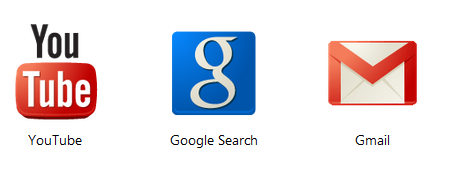
{ Thanks, Abhishek. }
1. The print preview page now integrates with Cloud Print. That means you can now print any webpage or PDF file using Cloud Print.

While Cloud Print makes more sense on a mobile phone or a tablet, you can also use it on your computer. The printer management page lets you share printers with your contacts just like you would share files in Google Docs. You're no longer limited to sharing a printer with other computers on the same network.
2. Chrome now has an interface for creating profiles. Go to Options > Personal Stuff and click "Add new user". After creating a new profile, Google asks you to log in using a Google Account and sync your settings and data, but this is optional. You can change the profile name and the icon that's always displayed in the top-left corner of the window. Profiles work just like the incognito mode, except that the data is saved and you can use multiple profiles at the same time. Just click the profile icon and you can open a new window in a different profile.
It's important to keep in mind that profiles can't be password-protected and they aren't intended to replace the user accounts from your operating system. Profiles are useful if you need different settings, bookmarks, apps at work, at school or in your past time. You can create a profile for games, install your favorite games from the Chrome Web Store, download a game-related theme and add some bookmarks.

3. YouTube, Gmail and Google Search are the apps that are automatically added when you install Chrome or create a new profile. The Search app was about to be removed because the icon was ugly.

{ Thanks, Abhishek. }
December 12, 2011
Changing the User Agent, a New Google Chrome Feature
Changing the user agent of a browser is sometimes helpful if you're visiting a site that doesn't work well in your browser or if you're a developer and you want to test a site. Until recently, changing the user agent required installing an extension, opening about:config or adding a command-line parameter.
Now that browsers started to include powerful developer tools and even Internet Explorer has a built-in user agent editor, Chrome added a similar feature. It's only available in Chrome 17 (Dev Channel / Canary) right now.
Here's how to change the user agent:
1. open the Developer Tools (Ctrl+Shift+I on Windows/Linux, Command - Option - I on Mac OS X)
2. click the "settings" icon at the bottom of the window
3. check "override user agent" and select one of the options (Internet Explorer 7/8/9, Firefox 4/7 for Windows/Mac, iPhone, iPad and Nexus S running Android 2.3). You can also select "other" and enter a custom user agent.
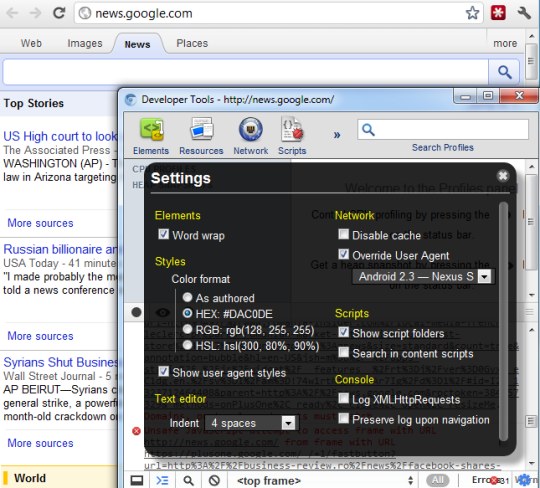
{ via François. Thanks, Venkat. }
Now that browsers started to include powerful developer tools and even Internet Explorer has a built-in user agent editor, Chrome added a similar feature. It's only available in Chrome 17 (Dev Channel / Canary) right now.
Here's how to change the user agent:
1. open the Developer Tools (Ctrl+Shift+I on Windows/Linux, Command - Option - I on Mac OS X)
2. click the "settings" icon at the bottom of the window
3. check "override user agent" and select one of the options (Internet Explorer 7/8/9, Firefox 4/7 for Windows/Mac, iPhone, iPad and Nexus S running Android 2.3). You can also select "other" and enter a custom user agent.

{ via François. Thanks, Venkat. }
December 10, 2011
Google Mobile Search Increases Text Size
Google Mobile Search increased the text size for search results and reduced the number of words from the snippets. While this change made search results more legible, it also reduced the number of results that are displayed before you start scrolling.
On an iPhone, Google only displays two results in their entirety, instead of three results, and the snippets are way too short.
Old UI:
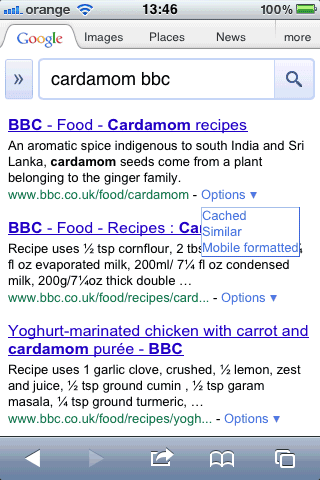
New UI:
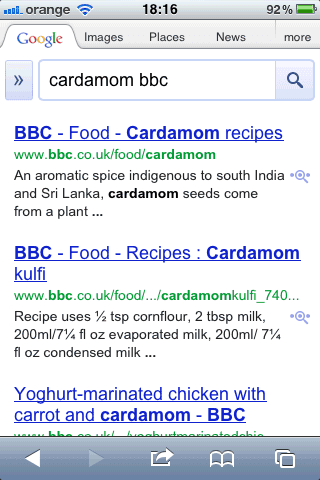
On an iPhone, Google only displays two results in their entirety, instead of three results, and the snippets are way too short.
Old UI:

New UI:

December 9, 2011
Google Search Pages Hide +1 Buttons
+1 buttons no longer clutter Google's search results pages. They're now displayed when you mouse over the results for most of the pages. If you have +1'd a page, the button will be displayed by default to highlight the result.
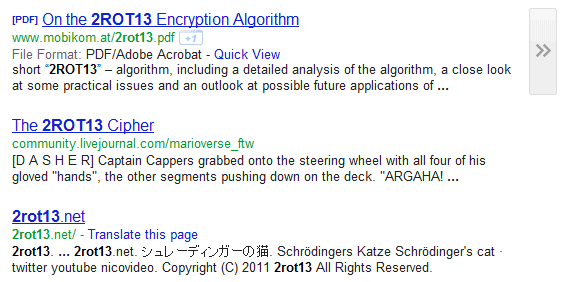
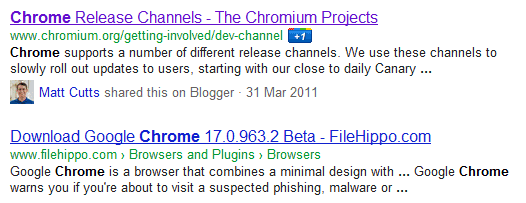
In other search-related news, the preferences page has a new interface with custom controls, while the advanced search page switched back to the old interface. Maybe someone read this post and decided to fix the drop-down lists.
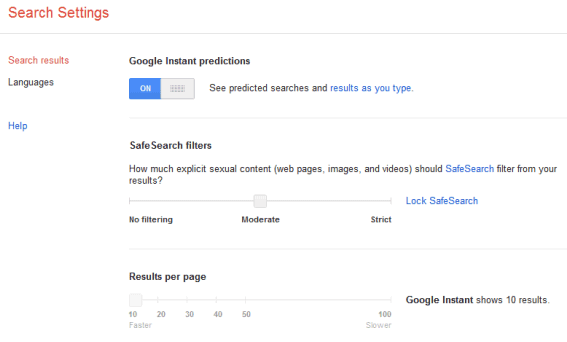


In other search-related news, the preferences page has a new interface with custom controls, while the advanced search page switched back to the old interface. Maybe someone read this post and decided to fix the drop-down lists.

Gmail Integrates With Google+
It looks like not only Google Contacts integrates with Google+. Gmail also added many features that make it easier to share files in Google+, add new people to your circles and find messages from these circles.
A lot of people complained that you can't find the messages sent or received by the members of a group. This feature is still not available, but you can restrict the messages to a circle. Gmail now displays the list of circles below the labels and you can use it to find mail from your family, friends, colleagues etc. It's obvious that groups are now less important than circles, even though I don't think they'll disappear.
"If you've spent time building your Google+ circles, you can now quickly use them to filter your mail, saving yourself from having to sift through that pile of daily deal emails and newsletters. You can see messages from all of your circles at once or from each individual circle. And if you want, you can show circle names on emails in your inbox. Contacts can also be filtered by circles, making it easier to view your social connections."
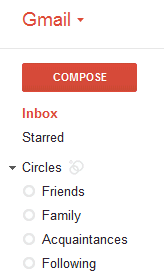
You can now add someone to a circle from the widget displayed in the right sidebar. There's also an easy way to share pictures from an email to Google+: just click "share" next to the attachment.
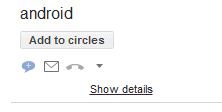
{ Thanks, Petros and Joost. }
A lot of people complained that you can't find the messages sent or received by the members of a group. This feature is still not available, but you can restrict the messages to a circle. Gmail now displays the list of circles below the labels and you can use it to find mail from your family, friends, colleagues etc. It's obvious that groups are now less important than circles, even though I don't think they'll disappear.
"If you've spent time building your Google+ circles, you can now quickly use them to filter your mail, saving yourself from having to sift through that pile of daily deal emails and newsletters. You can see messages from all of your circles at once or from each individual circle. And if you want, you can show circle names on emails in your inbox. Contacts can also be filtered by circles, making it easier to view your social connections."

You can now add someone to a circle from the widget displayed in the right sidebar. There's also an easy way to share pictures from an email to Google+: just click "share" next to the attachment.

{ Thanks, Petros and Joost. }
Face Recognition in Google+
Google+ is rolling out a feature called Find My Face, which helps other people tag you in their photos. Find My Face uses the face recognition data from Picasa Web Albums to make suggestions. The feature is disabled by the default and you can enable it from the settings page. Google says that it will share this data with the people you know, which probably means the people from your circles.
"Around the holidays, many of us get together with friends and family, and if you're like me, you take lots of photos! Tagging those photos can be a lot of work. So today we're launching Find My Face, an easier way to tag photos of yourself and your friends. By turning on Find My Face, Google+ can prompt people you know to tag your face when it appears in photos. Of course, you have control over which tags you accept or reject, and you can turn the feature on or off in Google+ settings. Find My Face will be rolling out over the next few days," informs Google.

Unlike Facebook, Google won't enable this feature by default. "We recognize that Google has to be extra careful when it comes to these [privacy] issues. Face recognition we will bring out once we have acceptable privacy models in place," said a Google employee back in March. VentureBeat concludes that "by making a simple opt-in procedure, Google will let the 'privacy-schmivacy' set enjoy the benefits of the new tech while sidestepping any accusations of dirty dealing from those who take privacy a bit more seriously".
{ Thanks, Venkat. }
"Around the holidays, many of us get together with friends and family, and if you're like me, you take lots of photos! Tagging those photos can be a lot of work. So today we're launching Find My Face, an easier way to tag photos of yourself and your friends. By turning on Find My Face, Google+ can prompt people you know to tag your face when it appears in photos. Of course, you have control over which tags you accept or reject, and you can turn the feature on or off in Google+ settings. Find My Face will be rolling out over the next few days," informs Google.

Unlike Facebook, Google won't enable this feature by default. "We recognize that Google has to be extra careful when it comes to these [privacy] issues. Face recognition we will bring out once we have acceptable privacy models in place," said a Google employee back in March. VentureBeat concludes that "by making a simple opt-in procedure, Google will let the 'privacy-schmivacy' set enjoy the benefits of the new tech while sidestepping any accusations of dirty dealing from those who take privacy a bit more seriously".
{ Thanks, Venkat. }
Google Currents
Flipboard is probably the most elegant app for reading news on an iPad (and now on the iPhone). Apple called it the iPad app of the year in 2010 and its success made other companies release magazine-like apps for reading news: Yahoo Livestand and now Google Currents.
Google's offering allows publishers to create mini-apps inside Google Currents. They can combine multiple feeds, photo streams and video streams, Google+ updates, create custom sections, add an icon and a splash page, customize the template and more. There are already 180 "editions" from sites like AllThingsD, Fast Company and more, but any site can be converted to an "edition" if it has a feed.
Currents is available in the US for iPhone, iPad and Android devices. You can only use it after signing in to your Google account, which has the benefit that all the settings are synced and you can read the same editions on different devices. You can add one of the built-in editions, import some of your Google Reader subscriptions or use the search feature to find blogs and news sites. Google also shows some popular stories from Google Trends.
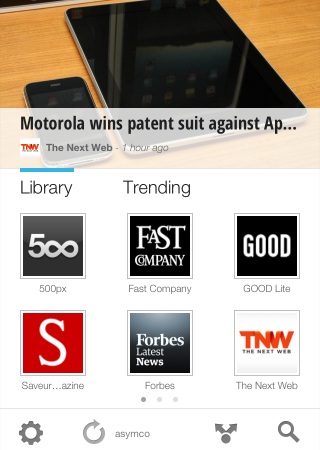
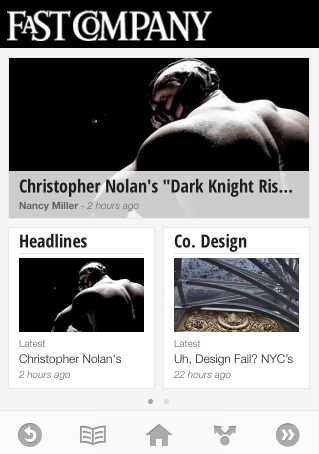
"Great content needs a great audience, which is why Google Currents is integrated with Google+ so users can share articles or videos they've enjoyed with their circles. Publishers can also associate their account with Google Analytics in order to increase their awareness of consumers' content preferences, device use and geographic distribution," informs Google.
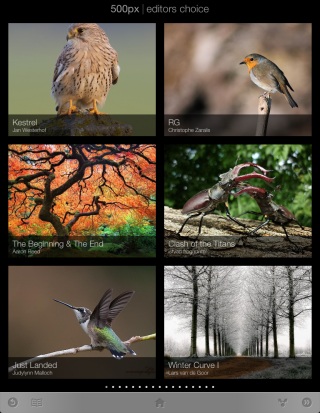
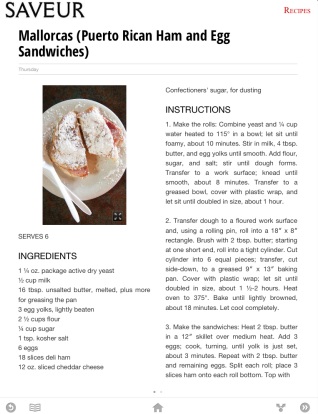
Google Currents automatically paginates articles, creates table of contents and emphasizes photos. The articles are synchronized, so you can read them even offline. This is especially useful if you have an Android device because the articles can be synchronized in the background.
Currents is a good alternative to apps like Flipboard and Pulse, but it doesn't integrate with Facebook and Twitter, the interface is not that smooth and it uses too many resources.
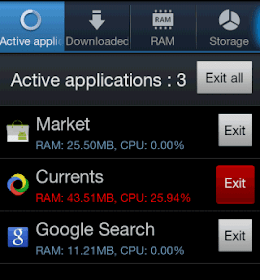
Update: Here's the Currents edition for this blog. You need to first install the Google Currents app on an iPhone, iPad or Android device and then click the link on your mobile device's browser.
Google's offering allows publishers to create mini-apps inside Google Currents. They can combine multiple feeds, photo streams and video streams, Google+ updates, create custom sections, add an icon and a splash page, customize the template and more. There are already 180 "editions" from sites like AllThingsD, Fast Company and more, but any site can be converted to an "edition" if it has a feed.
Currents is available in the US for iPhone, iPad and Android devices. You can only use it after signing in to your Google account, which has the benefit that all the settings are synced and you can read the same editions on different devices. You can add one of the built-in editions, import some of your Google Reader subscriptions or use the search feature to find blogs and news sites. Google also shows some popular stories from Google Trends.


"Great content needs a great audience, which is why Google Currents is integrated with Google+ so users can share articles or videos they've enjoyed with their circles. Publishers can also associate their account with Google Analytics in order to increase their awareness of consumers' content preferences, device use and geographic distribution," informs Google.


Google Currents automatically paginates articles, creates table of contents and emphasizes photos. The articles are synchronized, so you can read them even offline. This is especially useful if you have an Android device because the articles can be synchronized in the background.
Currents is a good alternative to apps like Flipboard and Pulse, but it doesn't integrate with Facebook and Twitter, the interface is not that smooth and it uses too many resources.

Update: Here's the Currents edition for this blog. You need to first install the Google Currents app on an iPhone, iPad or Android device and then click the link on your mobile device's browser.
Google Schemer: Social Goal Management
Schemer is an invite-only Google service for sharing and discovering things to do. "A scheme is any activity that can be done in the world, whether it's ordering a favorite dish at a restaurant or snorkeling in the Caribbean with sharks," explains Google.
Much like 43 Things, Schemer lets you define goals and mark the things you've already accomplished. You can inspire other people, find people who have the same goals and join the conversation. To make it easier to find a scheme, you can add tags and locations. Google also partnered with Bravo, Food Network, Rolling Stone, IGN and Entertainment Weekly, so you can get ideas from experts, not just from your friends.
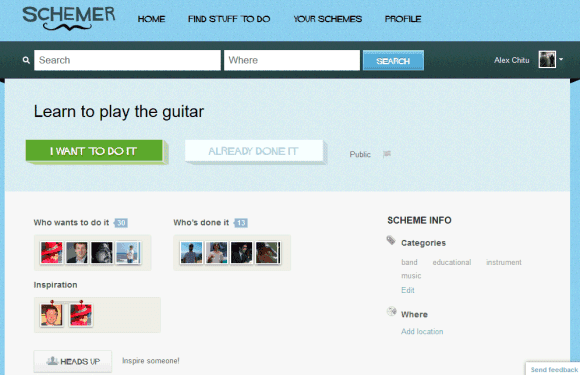
"Whether it's exploring a new city, checking out a friend's movie recommendation, or just finding new activities for your weekends, Schemer lets you discover new things to do, share schemes with friends, and make the most of your day," mentions Schemer's team. The service is integrated with Google+ and you need to join Google+ to be able to use it. "Schemer uses your profile picture and name from your Google+ account to identify you as a schemer user. This means that when you post a scheme, write a comment, post a reply, or indicate either you want to do or have done a scheme, your profile picture and name will be attached to those activities."
Schemer is actually a Google+ app and it's likely that you'll be able to use it inside Google+ in the future. Google also promises to launch a mobile app for Schemer so you can find schemes related to your location.
Now that Google+ no longer requires invitation, Schemer could make Google+ more popular. There's a great viral video, an interesting design and a site that doesn't look like a regular Google service. A scheme is "a secret or devious plan" (American Heritage Dictionary) and a schemer is a person who is involved in making these secret plans, so Google uses a mustache logo, a mesmerizing animated homepage, the Hitchcock font and catchy messages like "You're looking diabolical!" or "Invite your partners in crime".
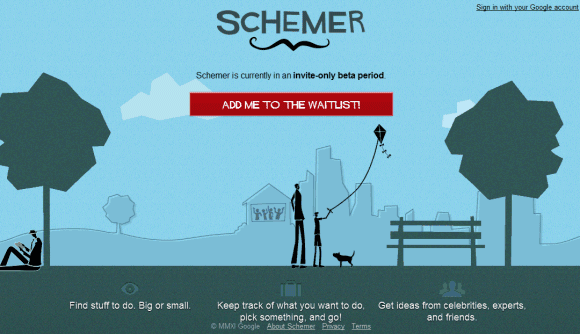
{ Thanks, Venkat. }
Much like 43 Things, Schemer lets you define goals and mark the things you've already accomplished. You can inspire other people, find people who have the same goals and join the conversation. To make it easier to find a scheme, you can add tags and locations. Google also partnered with Bravo, Food Network, Rolling Stone, IGN and Entertainment Weekly, so you can get ideas from experts, not just from your friends.

"Whether it's exploring a new city, checking out a friend's movie recommendation, or just finding new activities for your weekends, Schemer lets you discover new things to do, share schemes with friends, and make the most of your day," mentions Schemer's team. The service is integrated with Google+ and you need to join Google+ to be able to use it. "Schemer uses your profile picture and name from your Google+ account to identify you as a schemer user. This means that when you post a scheme, write a comment, post a reply, or indicate either you want to do or have done a scheme, your profile picture and name will be attached to those activities."
Schemer is actually a Google+ app and it's likely that you'll be able to use it inside Google+ in the future. Google also promises to launch a mobile app for Schemer so you can find schemes related to your location.
Now that Google+ no longer requires invitation, Schemer could make Google+ more popular. There's a great viral video, an interesting design and a site that doesn't look like a regular Google service. A scheme is "a secret or devious plan" (American Heritage Dictionary) and a schemer is a person who is involved in making these secret plans, so Google uses a mustache logo, a mesmerizing animated homepage, the Hitchcock font and catchy messages like "You're looking diabolical!" or "Invite your partners in crime".

{ Thanks, Venkat. }
December 8, 2011
Google Contacts Integrates With Google+
Gmail's contact manger started to include information from Google Profiles. You can also find your Google+ circles in the sidebar, below the list of groups.
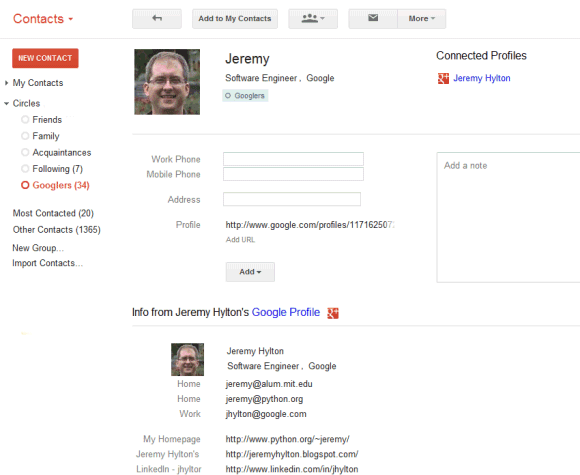
By default, the data obtained from Google Profiles is displayed below the information you've entered, but you can combine them: go to a contact page, click the "More" dropdown and select "[Show external data] inline".
It's interesting to notice that the Google Profiles data is automatically added when you enter an email address associated with a profile. To remove this information, just delete the corresponding email address.
The latest features are also available at google.com/contacts, which has recently switched to the new Google Contacts interface, but you can find them in the old Gmail interface, as well.
{ Thanks, Scott, Filipe, Venkat, Yavuz, Shimmy, Zachary and Matt. }

By default, the data obtained from Google Profiles is displayed below the information you've entered, but you can combine them: go to a contact page, click the "More" dropdown and select "[Show external data] inline".
It's interesting to notice that the Google Profiles data is automatically added when you enter an email address associated with a profile. To remove this information, just delete the corresponding email address.
The latest features are also available at google.com/contacts, which has recently switched to the new Google Contacts interface, but you can find them in the old Gmail interface, as well.
{ Thanks, Scott, Filipe, Venkat, Yavuz, Shimmy, Zachary and Matt. }
December 7, 2011
When Recent Searches Change Your Google Results
Google uses your search history to personalize the results for your future queries. That's not a new feature, but it was only used to disambiguate queries and to change the order of the results.
Now you might also see a small message next to the snippet which explains that the result was picked because you've searched for a different keyword before. For example, if you search for [tablet] and then search for [asus] Google will include some tablet-related search results and even highlight a page about the Asus Transformer. Right now, this feature is only available in the US.

Sometimes this could be useful. Google connects the dots and tries to provide better results by using keywords from your previous searches. But that's not always a good idea because two consecutive queries aren't necessarily related. You could search for [html table] and [blackberry] and the second result for [blackberry] will be:
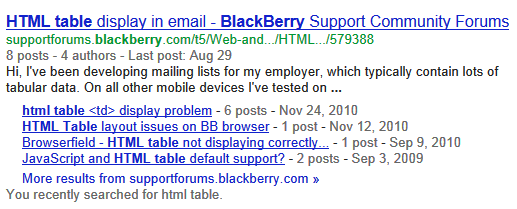
Google's algorithms aren't perfect and Google should provide an obvious way to hide the "enhanced" results. You can scroll to the bottom of the page, click "view customizations" and then click "without these improvements", you can also "disable customizations based on search activity" if you aren't logged in, but these options are cumbersome.
{ Thanks, Nick. }
Now you might also see a small message next to the snippet which explains that the result was picked because you've searched for a different keyword before. For example, if you search for [tablet] and then search for [asus] Google will include some tablet-related search results and even highlight a page about the Asus Transformer. Right now, this feature is only available in the US.

Sometimes this could be useful. Google connects the dots and tries to provide better results by using keywords from your previous searches. But that's not always a good idea because two consecutive queries aren't necessarily related. You could search for [html table] and [blackberry] and the second result for [blackberry] will be:

Google's algorithms aren't perfect and Google should provide an obvious way to hide the "enhanced" results. You can scroll to the bottom of the page, click "view customizations" and then click "without these improvements", you can also "disable customizations based on search activity" if you aren't logged in, but these options are cumbersome.
{ Thanks, Nick. }
Continuous Mode in Google Goggles
Google Goggles for Android has a new mode that lets you find information about objects without manually taking pictures. Just enable the continuous mode and Goggles will automatically analyze the scene, upload the photos to Google's servers and show the results at the bottom of the screen. "Continuous mode is a quick and easy new way to use Goggles. You can now get results instantly without having to take a picture - no shutter press required! Goggles will scan the scene continuously so you don't need to worry about taking multiple pictures. The new continuous mode works best with books, products, artwork, and landmarks," explains Google. For now, Goggles can't detect text in the continuous mode, so you need to switch to the snapshot mode to translate a text, find an address or call a phone number.
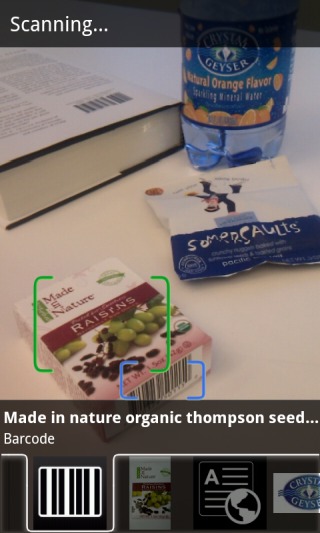
The "live" mode is useful if you want to scan many barcodes or if you want to find information about many objects without spending a lot of time taking the perfect photos. Goggles is still far from perfect, so it will sometimes detect a lot of incorrect objects. You'll need a fast Internet connection, good lighting and an Android phone with a decent camera. Unfortunately, the application doesn't save its findings. While it's obvious that cluttering the history is not a good idea, saving the list of detected objects to a temporary page would be really useful.
Google Goggles 1.7 also adds a feature that returns pages which include the text you've scanned, even if it's a long text. This is especially useful for news articles. Now you can quickly find the online version of the content you're reading.

You can improve Goggles by adding information about the objects you know. Tap "can you suggest a better result?", draw a box around the object and describe the object. "To date, hundreds of thousands of submissions have been made to improve Goggles. Starting today, if you choose to suggest a better result or submit a new object altogether, your suggestion could become a result for the next user who searches for a similar object with Goggles," informs Google.
If you have a device that runs Android Gingerbread, Honeycomb or Ice Cream Sandwich, install Goggles from the Android Market or update to the latest version. According to Google, about 50.6% of the Android devices run Gingerbread and 2.4% of the devices run Android Honeycomb.

The "live" mode is useful if you want to scan many barcodes or if you want to find information about many objects without spending a lot of time taking the perfect photos. Goggles is still far from perfect, so it will sometimes detect a lot of incorrect objects. You'll need a fast Internet connection, good lighting and an Android phone with a decent camera. Unfortunately, the application doesn't save its findings. While it's obvious that cluttering the history is not a good idea, saving the list of detected objects to a temporary page would be really useful.
Google Goggles 1.7 also adds a feature that returns pages which include the text you've scanned, even if it's a long text. This is especially useful for news articles. Now you can quickly find the online version of the content you're reading.

You can improve Goggles by adding information about the objects you know. Tap "can you suggest a better result?", draw a box around the object and describe the object. "To date, hundreds of thousands of submissions have been made to improve Goggles. Starting today, if you choose to suggest a better result or submit a new object altogether, your suggestion could become a result for the next user who searches for a similar object with Goggles," informs Google.
If you have a device that runs Android Gingerbread, Honeycomb or Ice Cream Sandwich, install Goggles from the Android Market or update to the latest version. According to Google, about 50.6% of the Android devices run Gingerbread and 2.4% of the devices run Android Honeycomb.
Google Remembers Your Old Passwords
If you change your Google account's password and you try to log in using the old password, Google shows a special message: "Your password was changed X days ago. Didn't change your password?" and links to this article.
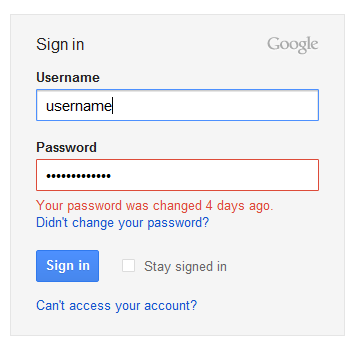
To show this message, Google needs to store your old password (actually, a password hash, since Google doesn't store the actual password). This is probably useful if someone managed to access your account and changed the password. Obviously, you'll still try the old password and you won't understand why it no longer works.
{ Thanks, Venkat and Brandon. }

It looks like you've attempted to sign in using an old password. If you remember changing your password, just sign back in using your most recent password. If you remember changing your password but have forgotten your new one, you can regain access to your account by going to our password assistance page.
If you don't remember changing your password, someone else might have accessed your account and changed your password. In some cases, your previous recovery email or phone might be available on the password assistance page for resetting your password. If that's not the case, you'll have the option to fill out our account recovery form to verify your identity and reclaim your account.
To show this message, Google needs to store your old password (actually, a password hash, since Google doesn't store the actual password). This is probably useful if someone managed to access your account and changed the password. Obviously, you'll still try the old password and you won't understand why it no longer works.
{ Thanks, Venkat and Brandon. }
December 6, 2011
Google Image Search Tests a New Tablet Interface
Google tests a new tablet interface for the image search engine. The new UI uses a carousel that lets you browse through the image results, just like the search app for iPad. Google no longer loads the corresponding websites and only focuses on the images.
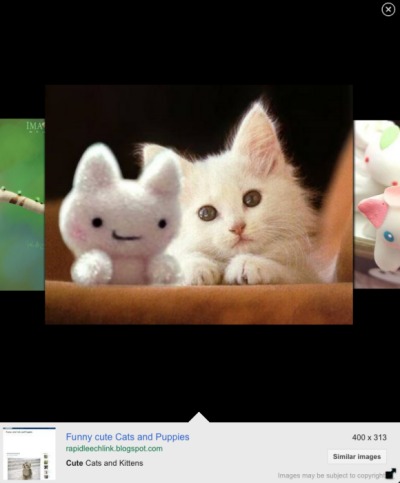

A similar slideshow is available in the smartphone interface and it will be interesting to see if it will be added to the desktop interface.


A similar slideshow is available in the smartphone interface and it will be interesting to see if it will be added to the desktop interface.
10 Billion Downloads in the Android Market
Google announced that the Android Market "exceeded 10 billion app downloads". The number is impressive, considering that the number of downloads was 1 billion in July 2010, but it's still lower than the number of downloads from Apple's App Store. In January, Apple announced that over 10 billion apps have been downloaded from the App Store. In July, the number grew to 15 billion downloads and it's likely that Apple will soon announce 20 billion downloads.
Google will celebrate the milestone by offering many popular apps for only 10 cents. "Starting today for the next 10 days, we'll have a new set of awesome apps available each day for only 10 cents each. Today, we are starting with Asphalt 6 HD ($6.99), Color & Draw for Kids ($0.99), Endomondo Sports Tracker Pro ($3.99), Fieldrunners HD ($2.99), Great Little War Game ($2.99), Minecraft ($6.99), Paper Camera ($1.99), Sketchbook Mobile ($1.99), Soundhound Infinity ($4.99), Swiftkey X ($3.99)," informs Google. Probably the most useful app is Swiftkey X, a really smart virtual keyboard, but you can download all the apps for only one dollar.
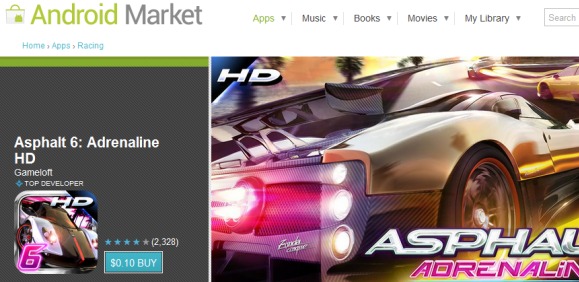
Google will celebrate the milestone by offering many popular apps for only 10 cents. "Starting today for the next 10 days, we'll have a new set of awesome apps available each day for only 10 cents each. Today, we are starting with Asphalt 6 HD (

December 5, 2011
Google's Graphing Calculator
Now you no longer need to use Wolfram Alpha to plot Math graphs. Google shows an interactive graph when you search for a Math function or a list of functions separated by commas. "You can zoom in and out and pan across the plane to explore the function in more detail. This feature covers an extensive range of single variable functions including trigonometric, exponential, logarithmic and their compositions, and is available in modern browsers," explains Google.
For example, you can search for [sin(x)/x, 1/x^2] to see this beautiful SVG graph.

You can also search for [sin(x) from -pi to pi] or add extraneous words like "plot", "graph" to the query (example: [graph ln(x)]).
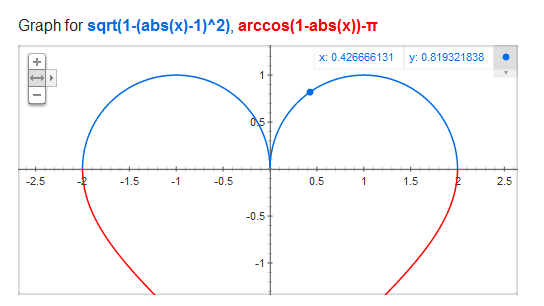
{ Thanks, Arpit. }
For example, you can search for [sin(x)/x, 1/x^2] to see this beautiful SVG graph.

You can also search for [sin(x) from -pi to pi] or add extraneous words like "plot", "graph" to the query (example: [graph ln(x)]).

{ Thanks, Arpit. }
December 1, 2011
More About YouTube's Latest Experimental Interface
A week ago, I reported that YouTube tests a new interface based on Cosmic Panda. The most important feature is the redesigned homepage that helps you find new channels and explore the videos from your subscriptions. YouTube started to post additional information about the new interface and it's now obvious that it will replace existing UI in the near future (the link only works after you've enabled the new interface).
"We've given YouTube a refresh. When you login, you'll be greeted with recent activity from your subscriptions. You can also browse and add new Channels to your homepage. Connect with Google+ and Facebook to share your favorites with friends. There's plenty to discover, so login and give it a spin."
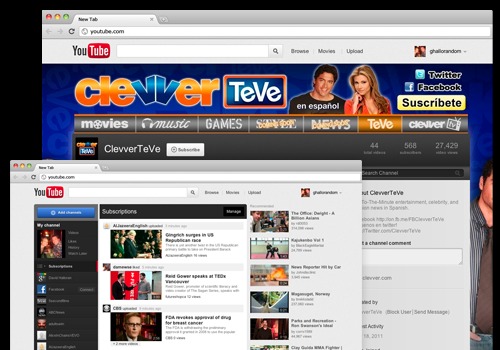
There's also an article about the new interface for channels.
It's interesting to notice that the new homepage and the new channels are built around feed views and activity streaming to make YouTube even more social.
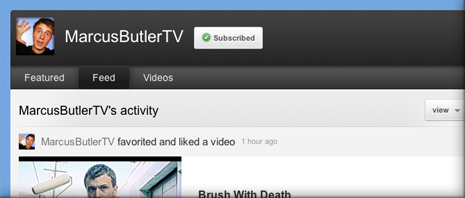
The new channels are less customizable: you can only choose an avatar, a background image, a background color and a template (creator, blogger, network, everything).
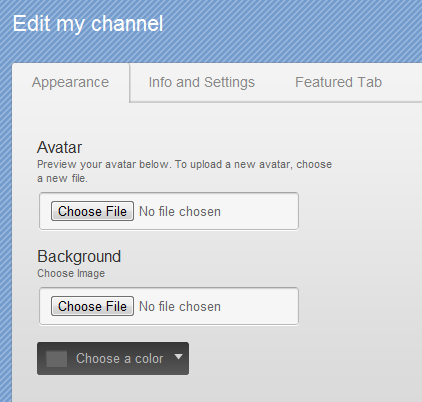
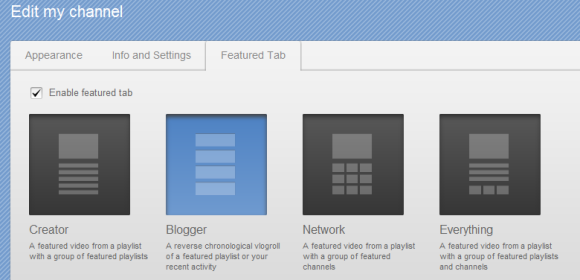
Update: The new interface is available for everyone.
"We've given YouTube a refresh. When you login, you'll be greeted with recent activity from your subscriptions. You can also browse and add new Channels to your homepage. Connect with Google+ and Facebook to share your favorites with friends. There's plenty to discover, so login and give it a spin."

There's also an article about the new interface for channels.
This new look and feel makes it easier for viewers to to find and watch content. It also makes it easier for Channel creators to organize and showcase exactly what they want. We incorporated your Feedback from the "Cosmic Panda" Channels and Watch experiment, and are excited to present:
* A more streamlined and consistent design
* An easier way to find and view videos
* New, more flexible layouts for featured content, and
* A way to keep your audience engaged even when you don't have new uploads
It's interesting to notice that the new homepage and the new channels are built around feed views and activity streaming to make YouTube even more social.

The new channels are less customizable: you can only choose an avatar, a background image, a background color and a template (creator, blogger, network, everything).


Update: The new interface is available for everyone.
